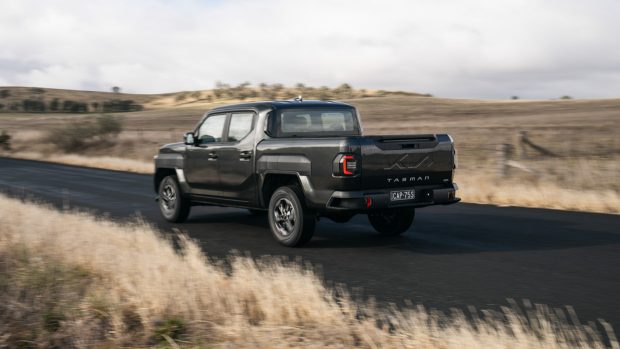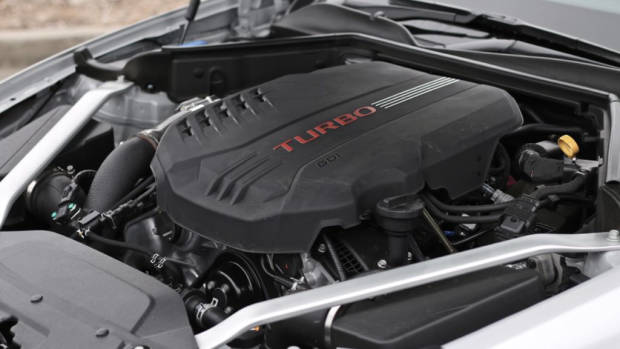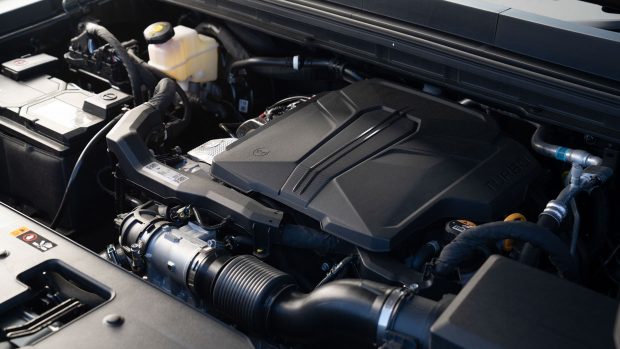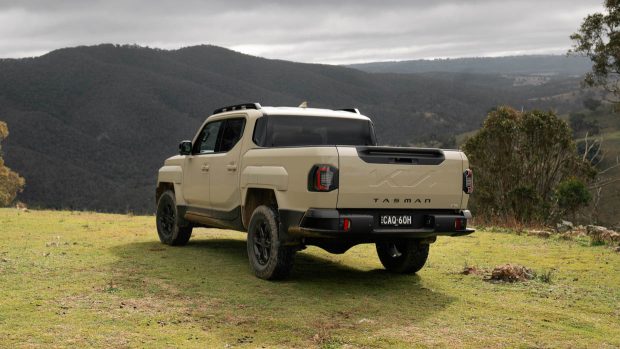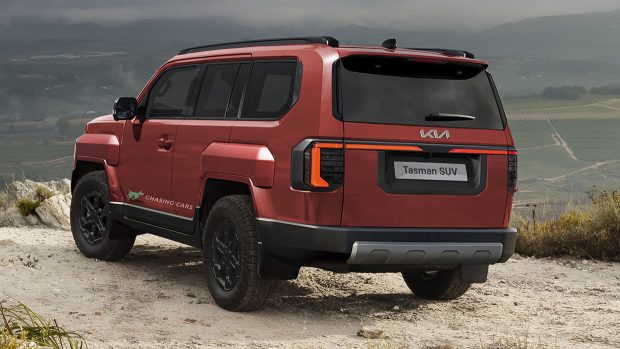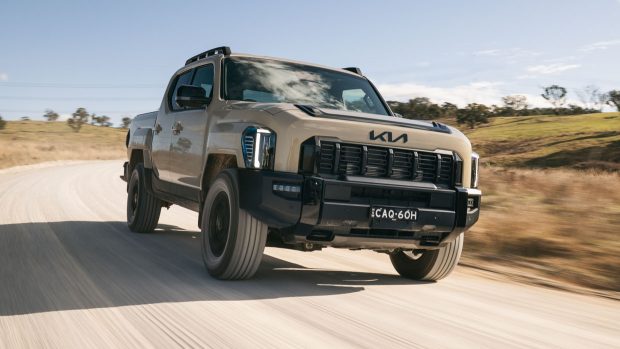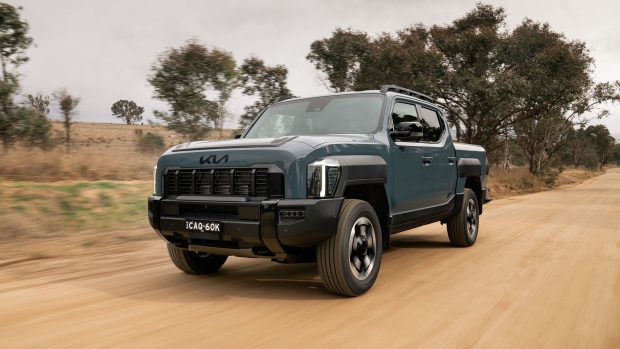-
Car Reviews
- Car News
-
Car Comparisons
Latest comparisons
- Chasing Deals
Australia’s emissions laws killed Tasman V6, but a number of facelifts have been locked in accompanied by new or updated engines
Kia plans to sell the Tasman ute in first-generation form for 10 years, with a comprehensive plan of design and powertrain updates already locked in for the lifecycle of the pick-up.
The Tasman will be facelifted about every three years, with visual changes expected in 2027, 2030, and 2033. The arrival of a new facelift will also coincide with powertrain changes as Kia works to keep the Tasman reasonably compliant with emissions regulations.
Hopes of a six-cylinder engine for the Tasman have been effectively extinguished, however, with senior Kia Australia executives confirming that New Vehicle Emissions Standard (NVES) laws meant petrol or diesel V6 engines, which were explored for Tasman, had to be ruled out.
“Would we have liked to have seen the Stinger engine, a bi-turbo V6, [in Tasman]? It would have been pretty cool,” Kia Australia general manager of product planning Roland Rivero told Chasing Cars.
“But under NVES, and all the other things we have to balance out, [a V6] doesn’t make sense from a feasibility perspective. The maths don’t work out.”
Rivero, speaking with Chasing Cars alongside Kia Australia chief executive officer Damien Meredith and chief operating officer Dennis Piccoli, confirmed that even a Ranger-rivalling diesel V6 (as opposed to Stinger’s petrol ‘six) was not globally feasible for Tasman.
That means the powertrain upgrades (or at least updates) that will roll out for the Tasman ute across the next 10 years should be expected to concentrate on reducing CO2 emissions—though this goal could still be delivered alongside more power and torque.
“The Tasman will have a role to play for at least 10 years,” Kia boss Meredith said. “The [154kW/440Nm] 2.2 diesel engine is a solid engine. The gearing they have been able to do with Tasman is exceptional.”
Rivero affirmed that diesel four-cylinders such as Kia’s 2.2-litre still represent 80 percent of ute sales in Australia, but confirmed the Korean marque is aware that the game will keep moving forward.
“We don’t want to compromise on the capability requirements of the customer, but we’re not just going to sit back and relax on the powertrain options of Tasman,” Rivero said.
Kia Australia is keeping a close eye on the performance of the BYD Shark 6 and other plug-in hybrid (PHEV) utes such as the GWM Cannon Alpha. Mr Meredith was particularly complimentary of BYD’s ute sales success.
“They’ve got a lot of sales. I think (BYD) has done a great job hitting a slither of the segment as it has done before with other models. They’ve done it very, very well,” Meredith said.
However, Meredith warned that insufficient technical durability, or issues with warranties, could do long-term harm to new technologies like PHEV utes.
Chasing Cars understands that some development work on a battery electric (BEV) version of the Tasman has been completed but this has been deferred for now due to uncertainty of BEV demand.
Still, the plan at Kia Australia is to make a success of the Tasman. The brand has a very public target of 20,000 Tasman sales per year, which would see the ute slot sit around number four in the market, being roughly equivalent to an Isuzu D-Max.
The plan is to convince Korea to develop not only a Tasman SUV, but also a second generation of the Tasman ute to launch in the mid-2030s.
“We’re going to constantly reveal what we need to do for Tasman to give it the longevity to see a second generation 10 years from now. It’s going to constantly evolve over the next 10 years,” Rivero said.
Kia bosses plan to get to that point by rallying excitement around each successive Tasman facelift, noting examples of recent facelifts, including to the Sorento SUV, that managed to increase sales.
“It depends how you execute your facelift,” Rivero said. “If the execution is worthwhile and noticeable in the marketplace, it can continue sales momentum or even grow sales momentum, in the case of what’s happened with Toyota Hilux in the past.”
A critical way Kia will build facelift excitement is to align the launch of new or updated engines for the Tasman with design changes.
“I think it’s hard to suddenly put a [new] powertrain in place in 12 months, for example. I wouldn’t say it would be a running change. If we were to put a crystal-ball timeline, it would be the next [facelift],” Rivero said, before providing a hint on expected powertrain changes.
“[That would include] tweaks to additional powertrains in response to NVES, or there could be technologies like idle stop and go that lowers your CO2 footprint,” he said.
Rivero confirmed that Kia’s R&D centre is exploring hybrid systems that would allow the Tasman to retain its 3500kg braked towing capacity – a capability Kia Australia sees as pivotal to the Tasman ute’s credibility.
Ensuring the Tasman plays its part in Kia’s overall NVES compliance strategy will safeguard the ute’s future, executives believe. But Meredith believes utes have a strong future ahead in Australia, despite predicting Labor – the author of NVES – to be re-elected at least twice more.
“There is metropolitan Australia and there is rural and provincial Australia. Sometimes their needs and wants are not the same,” Meredith said.
Latest news
About Chasing cars
Chasing Cars reviews are 100% independent.
Because we are powered by Budget Direct Insurance, we don’t receive advertising or sales revenue from car manufacturers.
We’re truly independent – giving you Australia’s best car reviews.
